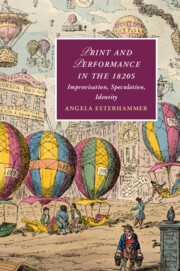Book contents
- Print and Performance in the 1820s
- Cambridge Studies in Romanticism
- Print and Performance in the 1820s
- Copyright page
- Contents
- Illustrations
- Acknowledgements
- Chapter 1 Introduction: Being There, circa 1824
- Chapter 2 Periodical Performances
- Chapter 3 Mediating Improvisation and Improvising Mediation
- Chapter 4 Personal Identity, Impersonation, and Charles Mathews
- Chapter 5 Theodore Hook’s Sayings and Doings on the Page and the Stage
- Chapter 6 Speculating on Property
- Chapter 7 Scottish Fictions of 1824
- Notes
- Bibliography
- Index
- Cambridge Studies in Romanticism
Chapter 7 - Scottish Fictions of 1824
Permutations of Identity
Published online by Cambridge University Press: 11 March 2020
- Print and Performance in the 1820s
- Cambridge Studies in Romanticism
- Print and Performance in the 1820s
- Copyright page
- Contents
- Illustrations
- Acknowledgements
- Chapter 1 Introduction: Being There, circa 1824
- Chapter 2 Periodical Performances
- Chapter 3 Mediating Improvisation and Improvising Mediation
- Chapter 4 Personal Identity, Impersonation, and Charles Mathews
- Chapter 5 Theodore Hook’s Sayings and Doings on the Page and the Stage
- Chapter 6 Speculating on Property
- Chapter 7 Scottish Fictions of 1824
- Notes
- Bibliography
- Index
- Cambridge Studies in Romanticism
Summary
A concluding discussion of personal and textual identities, doubling, and fraud centres on a constellation of Scottish novels. Galt’s Andrew of Padua, the Improvisatore (1820) is a pseudo–autobiography wrapped in a pseudo–translation that leads readers on into a multilayered, improvised hoax. Republished together with his novel Rothelan in 1824, Galt’s tale joins several novels about imitation and imposture published almost simultaneously in that year: Hogg’s Private Memoirs and Confessions of a Justified Sinner, Scott’s Redgauntlet, Susan Ferrier’s Inheritance, Sarah Green’s Scotch Novel Reading, and versions of Walladmor by Willibald Alexis and Thomas De Quincey. Together, these works show how not only personal identity but also historical events and books themselves can be fraudulently duplicated. From the psychologically fragmented identities and demonic doubling illustrated in Hogg’s Private Memoirs to the fraudulent pseudo–translation Walladmor, these novels interweave the practices of speculation and identity construction typical of late-Romantic print and performance culture.
Keywords
- Type
- Chapter
- Information
- Print and Performance in the 1820sImprovisation, Speculation, Identity, pp. 172 - 210Publisher: Cambridge University PressPrint publication year: 2020

